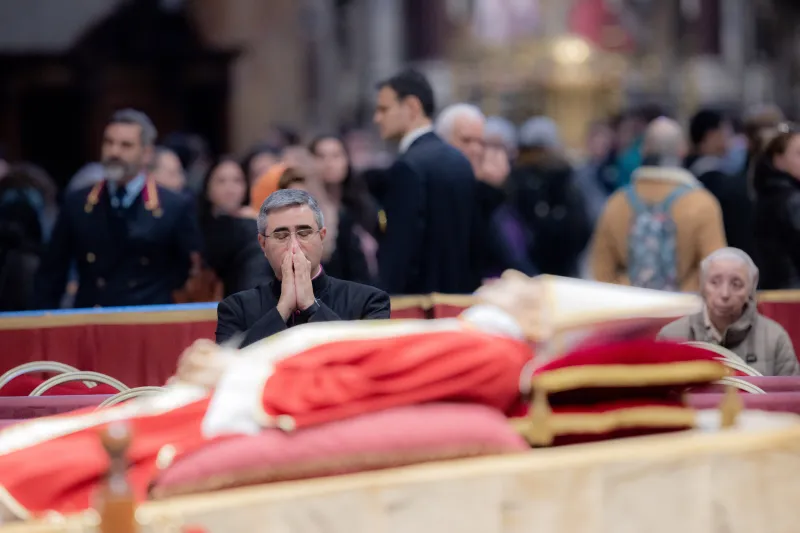
Vatican City, Jan 3, 2023 / 01:46 am (CNA).
Following the death of Pope Emeritus Benedict XVI, these are the details you should know about his funeral in the Vatican.
Benedict XVI passed away on December 31 at 9:34 am (Rome time). As confirmed by his personal secretary Archbishop Georg Ganswein, his last words were “Signore, ti amo !” (Lord, I love you!) And he pronounced them in Italian.
Unlike the death of Saint John Paul II in 2005, the death of the Pope Emeritus was not announced in Saint Peter’s Square nor was there a peal of bells. Confirmation of his death was reported by the director of the Vatican Press Office, Matteo Bruni.
Bruni told reporters that “following the wishes of the Pope Emeritus, the funeral will be held under the sign of simplicity,” stressing that it will be a “solemn but sober funeral.”
“The express request on the part of the emeritus pope is that everything be simple, both with regard to the funeral, as well as the other celebrations and gestures during this time of pain,” he added.
After his death, the remains of Benedict XVI remained in the Mater Ecclesiae Monastery, his place of residence since his resignation in 2013. The small monastery is located in the Vatican Gardens, on a hill behind St. Peter’s Basilica.
On January 1, 2023, the Holy See released the first images of the body of the Pope Emeritus with a rosary in his hand and lying at the foot of the altar in the monastery’s chapel. The chapel is the same place where, in addition to celebrating Mass, it received public visits from Pope Francis and the new cardinals every time there was a consistory in the Vatican. Since it continues to be Christmas liturgically, the chapel still has a small Christmas tree and a manger.
Next to the remains of Benedict XVI, some kneelers were placed for prayer.
A few hours later dozens of people including cardinals, bishops, priests, Vatican workers, nuns from different congregations and even journalists who cover the activities of the Holy See, were able to enter the monastery to keep vigil and pray with the remains of the Pope before they were transferred to San Peter.
At 7:00 am on January 2, the body of the Pope Emeritus was transferred from the Mater Ecclesiae Monastery to St. Peter’s Basilica to begin the wake and allow thousands of pilgrims to say their last goodbyes.
The Archpriest of the Basilica, Cardinal Mauro Gambetti, received the remains of Benedict XVI with a liturgical act that lasted about 30 minutes.
Among the attendees were Bishop Georg Ganswein, who was his personal secretary since 2003, and the master of liturgical celebrations, Bishop Diego Ravelli.
From 9:00 am to 7:00 pm the faithful from all over the world were allowed to enter St. Peter’s Basilica to visit the body of Benedict XVI.
It is estimated that at least 65,000 people came to visit the Pope Emeritus on the first day of his wake.
The remains of Benedict XVI will remain on display in St. Peter’s Basilica until Wednesday, Jan. 4. Visiting hours for Tuesday and Wednesday are from 7:00 a.m. to 7:00 p.m. (Rome time).
Funeral of Benedict XVI
Pope Francis will preside over the funeral of Benedict XVI on Thursday, January 5 at 9:30 a.m. (Rome time), in St. Peter’s Square.
Two official state delegations, those of Italy and Germany, will attend the funeral of Pope Emeritus Benedict XVI.
The President of Italy, Sergio Mattarella, was one of the first to visit the funeral chapel of Pope Benedict XVI. Prime Minister Giorgia Meloni, accompanied by other officials from her government, also attended on the morning of Monday, January 2, and prayed for several minutes before the remains of the Pope Emeritus.
Many other heads of state will come to pay respects and attend the funeral in an unofficial capacity, including the President of Hungary, Katalin Novak; the President of Poland, Andrzej Duda; King Philip of Belgium; and Queen Sofia of Spain, among others.
The funeral of Benedict XVI will be held at 9:30 a.m. on Thursday, Jan. 5. You can view it live on EWTN here.
This article was originally published by our sister agency, ACI Prensa. It has been translated and adapted by CNA.
If you value the news and views Catholic World Report provides, please consider donating to support our efforts. Your contribution will help us continue to make CWR available to all readers worldwide for free, without a subscription. Thank you for your generosity!
Click here for more information on donating to CWR. Click here to sign up for our newsletter.




Leave a Reply